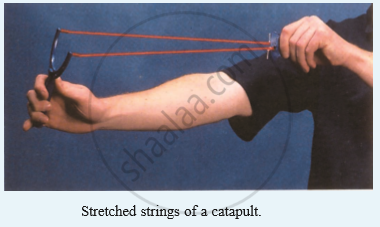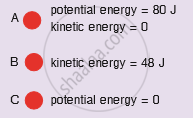Advertisements
Advertisements
प्रश्न
A ball of mass 0.5 kg slows down from a speed of 5 m/s so that of 3 m/s. Calculate the change in kinetic energy of the ball. State your answer giving proper units.
उत्तर
Mass of the ball, (m) = 0.5 kg
Initial velocity, (v1) = 5 m/s
Final velocity, (v2) = 3 m/s
So, initial kinetic energy can be calculated as,
`K.E = 1/2 mv^2`
Therefore, initial kinetic energy,
`(K.E)_1 = 1/2 xx 0.5 xx 5^2` J
= 6.25 J
Similarly, final kinetic energy,
`(K.E)_2 = 1/2 xx 0.5 xx 3^2` J
= 2.25 J
So, Work done = Change in kinetic energy
Therefore work done,
Work done = (KE)2 – (KE)1
= (2.25 – 6.25) J
= – 4 J
A negative sign shows that the force applied is opposite to the direction of motion of the body.
APPEARS IN
संबंधित प्रश्न
A ball is placed on a compressed spring. What form of energy does the spring possess? On releasing the spring, the ball flies away. Give a reason.
What kind of energy is possessed by the following?
A stretched rubber band _____________
What type of energy is possessed : by the stretched rubber strings of a catapult?
Fill in the blank with suitable word:
The electricity meter installed in our homes measure electrical energy in the units of ___________.
Fill in the blanks with suitable words :
The principle of ___________ of energy says energy can be transformed from one form to another, but it cannot be ___________ or ___________.
What kind of energy transformation take place at a hydroelectric power station?
What kind of energy transformations take place at a coal-based thermal power station?
How much electric energy in kWh is consumed by an electrical appliance of 1000 watts when it is switched on for 60 minutes?
A ball falls to the ground as shown below :
Which law you have made use of in answering this question?
A body of mass 10 kg at rest is acted upon simultaneously by two forces 4 N and 3 N at right angles to each other. The kinetic energy of the body at the end of 10 s is
